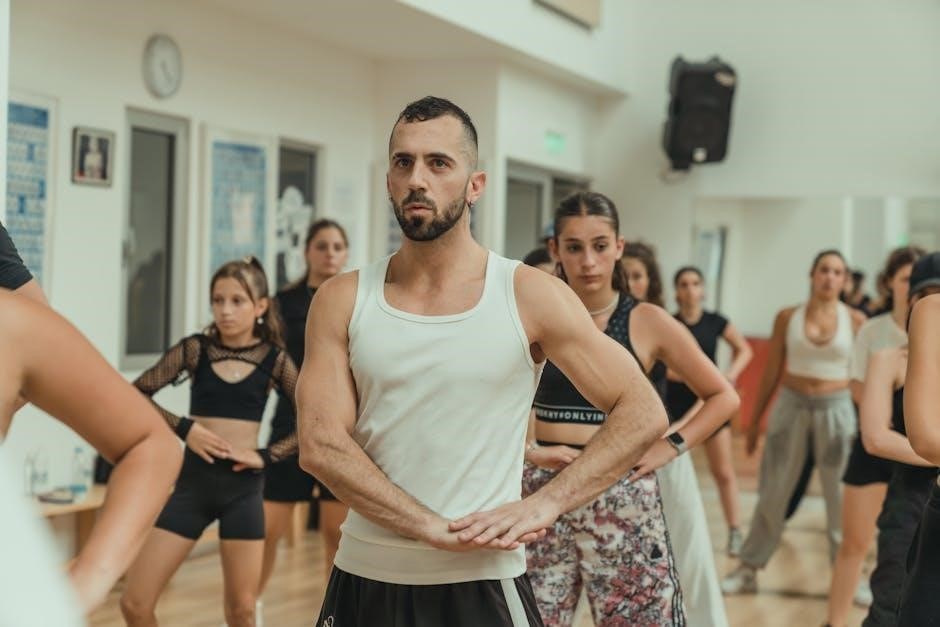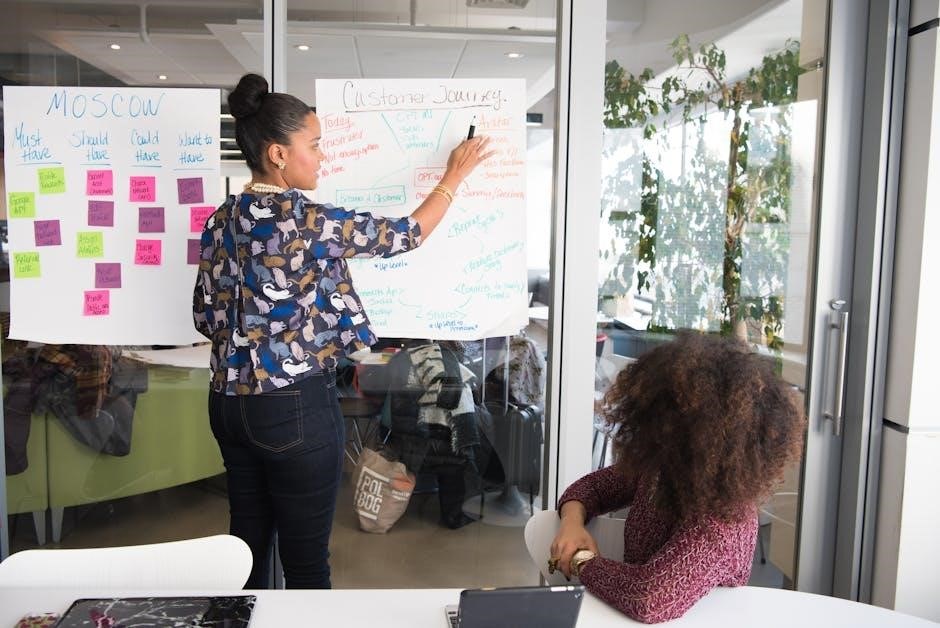Situational leadership is a flexible management model developed by Paul Hersey and Kenneth Blanchard, focusing on adapting leadership styles to followers’ needs and maturity levels.
It emphasizes matching leadership behaviors to the specific demands of tasks and individuals, ensuring effective guidance and support in diverse organizational contexts.
Overview of the Hersey-Blanchard Situational Leadership Model

The Hersey-Blanchard Situational Leadership Model is a flexible framework that guides leaders to adapt their styles based on followers’ readiness and task requirements.

Developed by Paul Hersey and Kenneth Blanchard, the model identifies four leadership styles: Directing, Coaching, Supporting, and Delegating.
These styles correspond to four follower development levels, ranging from low competence and high commitment (D1) to high competence and low commitment (D4).
The model emphasizes matching leadership behaviors to the specific needs of individuals or teams, ensuring effective task completion and personal growth.
By focusing on situational factors, the model provides a practical approach for leaders to enhance productivity and employee satisfaction in diverse organizational contexts.

Historical Background and Development of the Theory
The Hersey-Blanchard Situational Leadership Theory was developed in the late 1970s and early 1980s by Paul Hersey and Kenneth Blanchard.
Hersey introduced the Situational Leadership Model, while Blanchard later refined it with the Situational Leadership II model.
The theory emphasizes that effective leadership depends on adapting one’s style to the maturity and readiness of followers.
It evolved from earlier leadership theories, focusing on flexibility and context-specific approaches to management.
The model initially outlined four leadership styles and four follower development levels, providing a practical framework for leaders.
Over time, the theory has been widely adopted in organizational settings, enhancing productivity and employee satisfaction through tailored leadership strategies.

Core Concepts of the Hersey-Blanchard Model
The model centers on adapting leadership styles to follower readiness, emphasizing four styles and four development levels to maximize effectiveness in varying situational demands.
Leadership Styles: Directing, Coaching, Supporting, and Delegating
The Hersey-Blanchard model identifies four distinct leadership styles: Directing, Coaching, Supporting, and Delegating. Each style corresponds to the developmental level of followers, ensuring optimal guidance and support.
Directing involves high task focus and low relationship behavior, suitable for employees with low competence and commitment. Leaders provide clear instructions and closely monitor progress.
Coaching combines task direction with increased relationship focus, ideal for followers with some competence but variable commitment. Leaders encourage skill development and provide feedback.
Supporting emphasizes high relationship behavior and low task focus, appropriate for individuals with high competence but lacking confidence. Leaders act as facilitators, offering support and resources.
Delegating involves minimal task and relationship focus, reserved for highly competent and committed followers. Leaders trust employees to handle tasks independently, focusing on outcomes rather than methods.

These styles are not static; effective leaders adapt them based on situational demands and follower readiness to achieve organizational goals efficiently.
Follower Development Levels: Maturity and Readiness
The Hersey-Blanchard model categorizes followers into four development levels based on their maturity and readiness to perform tasks. These levels determine the appropriate leadership style to apply.
D1: Low Maturity ౼ Followers lack the necessary skills and confidence, requiring close supervision and clear instructions. Leaders should use a Directing style to build competence.
D2: Some Maturity — Followers possess some skills but may lack confidence or commitment. A Coaching style is effective, balancing guidance with encouragement to enhance their abilities.
D3: High Maturity ౼ Followers are skilled but may lack confidence in specific tasks. A Supporting style fosters independence by providing emotional support and resources while gradually reducing direct involvement.
D4: Very High Maturity — Followers are highly skilled and confident, needing minimal supervision. A Delegating style is appropriate, allowing them to take full responsibility for tasks.
Understanding and accurately assessing these development levels is crucial for leaders to apply the most effective leadership approach in various situations.
Practical Application of the Model
The Hersey-Blanchard model is applied by assessing follower readiness, then selecting the appropriate leadership style to match their maturity and task requirements, ensuring effective guidance and support.
Adapting Leadership Styles to Different Situations
Adapting leadership styles to different situations is a cornerstone of the Hersey-Blanchard model. Leaders must assess the maturity and readiness of their team members to determine the appropriate approach. In situations where employees are inexperienced or lack confidence, a directing style is most effective, involving clear instructions and close supervision. As individuals gain competence and commitment, a coaching style can be employed, providing guidance while encouraging independence. When team members are capable but lack motivation, a supporting style fosters encouragement and involvement in decision-making. Finally, for highly skilled and self-assured individuals, a delegating style allows them to work independently, with the leader intervening only when necessary. This flexibility ensures that leadership behaviors align with the specific needs of the situation, optimizing both individual and team performance.
Matching Leadership Behaviors to Follower Needs

Matching leadership behaviors to follower needs is a core principle of the Hersey-Blanchard model. Leaders must align their style with the maturity and readiness of their team members to maximize effectiveness. For instance, when followers are at the earliest development level (D1), characterized by low competence and high commitment, a directing style is most appropriate. As followers progress to D2 (moderate competence, variable commitment), a coaching style helps build skills and confidence. At D3 (high competence, limited commitment), a supporting style focuses on motivation and involvement. Finally, at D4 (high competence and high commitment), a delegating style empowers followers to take full responsibility. This tailored approach ensures that leaders provide the right level of guidance, support, and autonomy, fostering both individual growth and team success. Flexibility in leadership is key to meeting the unique needs of each follower.

Benefits and Effectiveness of the Model
The Hersey-Blanchard model’s flexibility enhances leadership effectiveness, enabling leaders to adapt to diverse situations and follower needs, improving overall performance and employee satisfaction effectively.

Case Studies and Real-World Examples
The Hersey-Blanchard model has been successfully applied in various organizations to enhance leadership effectiveness. For instance, the Guyana Police Force utilized situational leadership principles to address leadership gaps and improve succession planning. Similarly, corporate teams have adopted the model to align leadership styles with employee maturity levels, fostering better collaboration and productivity. Real-world examples highlight how situational leadership enables leaders to adapt their approach, ensuring tasks are completed efficiently while developing team members’ skills. These case studies demonstrate the model’s practicality in diverse contexts, from law enforcement to corporate environments, proving its effectiveness in driving organizational success and employee growth.
Training and Development Opportunities
Training programs based on the Hersey-Blanchard Situational Leadership Model equip leaders with the skills to adapt their styles to their team’s needs. These programs often include workshops and interactive exercises that teach leaders how to assess follower readiness and implement the appropriate leadership approach. Leaders learn to transition between directing, coaching, supporting, and delegating, fostering a more dynamic and effective leadership environment. Such training enhances leadership flexibility and promotes employee development, leading to improved job satisfaction and organizational performance. Many organizations have successfully integrated these training initiatives, resulting in measurable improvements in team collaboration and goal achievement. The practical application of situational leadership principles empowers leaders to create a supportive and productive work culture, aligning with the model’s emphasis on matching leadership behaviors to follower needs.

